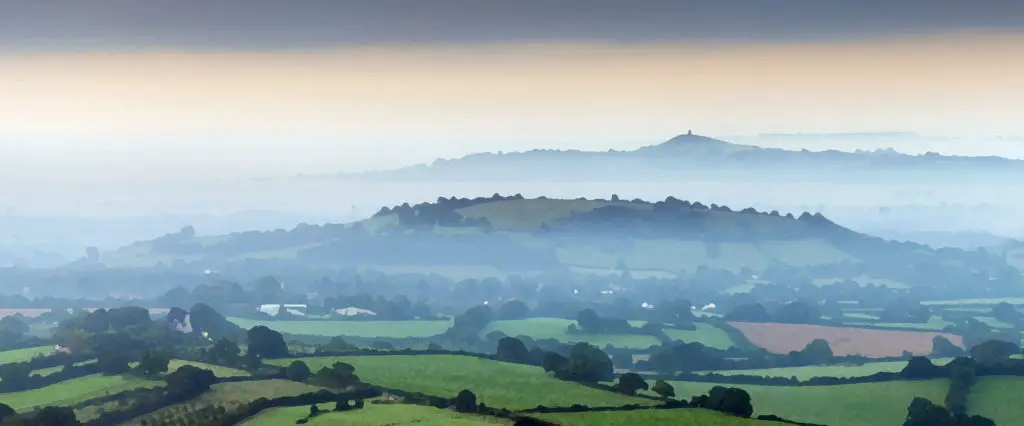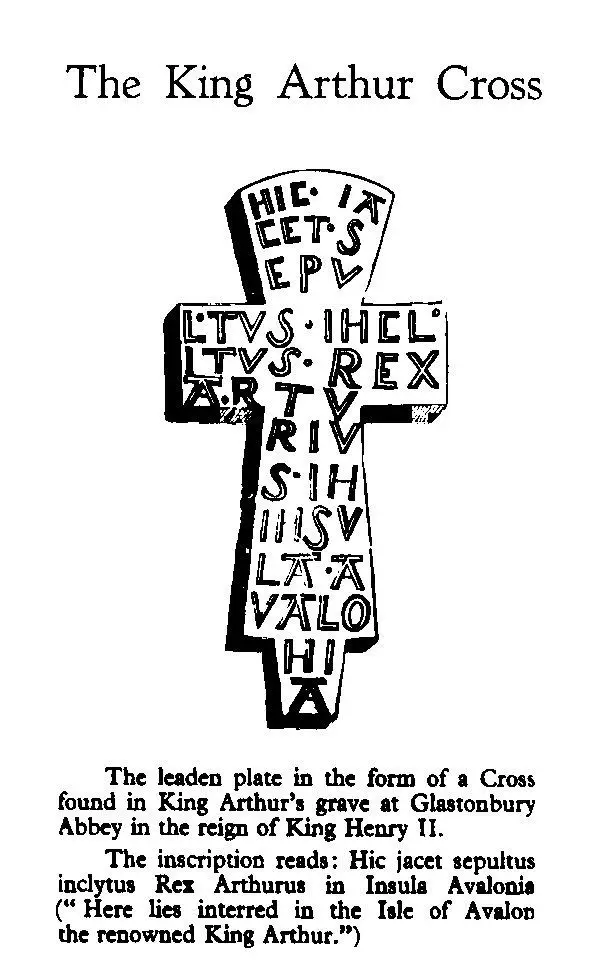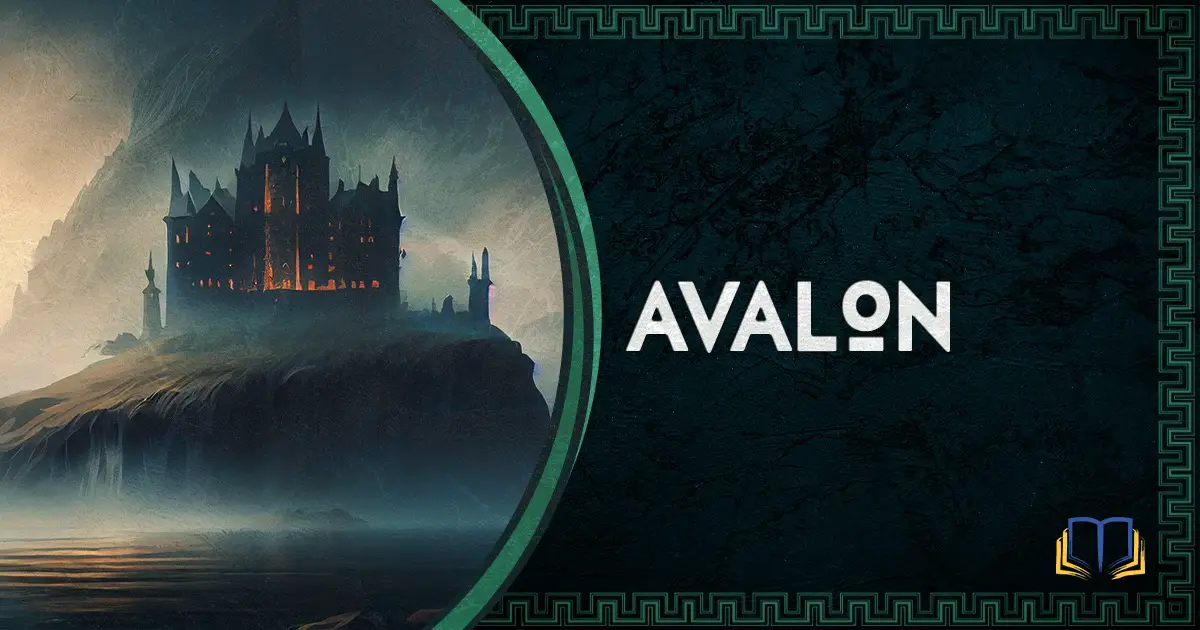Avalon is an important location within the Arthurian legends. It is not only the place where Arthur was taken after the Battle of Camlann (and either died or recovered, depending on the legend), but it was also the home of many powerful sorceresses, including Morgan le Fay.
But there’s still a lot of mystery surrounding Avalon, which is why in this article, we’ll be walking through the basics, as well as some more advanced topics you might not have heard about before.
In this article, we’ll cover:
- Where Avalon is likely located
- Whether Arthur is actually buried there
- Avalon as depicted in popular culture
Don’t forget to check out the Arthurian 101 page for all things King Arthur.
What Is the Isle of Avalon?
The Isle of Avalon is a legendary island that features prominently in Arthurian mythology. It is said to be the final resting place of King Arthur and the place where the sword Excalibur was forged. The island is also said to be the home of the enchantress Morgan le Fay, who is sometimes portrayed as a benevolent sorceress and healer.
The exact location of the Isle of Avalon is unclear, as it is often described as a magical realm that is difficult to access. Some sources place it off the coast of Wales, while others suggest that it is located in the English Channel or even in a parallel dimension.
We’ll dive into some of those theories below.
In Arthurian legend, the Isle of Avalon is also associated with the concept of the Otherworld, a realm of supernatural beings and powerful magic. It is often portrayed as a place of healing and rejuvenation, and is sometimes depicted as a paradise-like land of eternal youth and beauty.
The name Avalon comes from the Old welsh words “aball’ or “avallen,” meaning ‘apple tree’ or ‘fruit tree.’
Many other Arthurian novels include Avalon as an important location, including Le Morte d’Arthur by Thomas Malory, the Vulgate Cycle, written by authors unknown in the 13th century, and Lope Garcia de Salazar’s Roman du Graal.
Historical References to Avalon
In Geoffrey of Monmouth’s Historia Regum Britanniae, he described Avalon as an island where King Arthur’s sword, Excaliber, was forged and also where Arthur was taken after the battle of Camlann to have his wounds healed.
Later the same author described the island in Vita Merlini as the “island of apples.” Morgan Le Fay and her eight sisters–all of them talented in healing arts– ruled the island.
Dominant Theory: Avalon Is Glastonbury Tor

One of the most popular speculations is that Avalon is a rise of earth, known as Glastonbury Tor, surrounded by the 160,000 acres known as Somerset Levels or lowlands near the modern town of Glastonbury in Somerset England.
The cone-shaped hill is made of clay and blue lias which are layers of shale and limestone. The hill rises from the low lands and was formed when softer deposits eroded, leaving the hard sandstone exposed.
Etymology of “Glastonbury”
The name Glastonbury is probably derived from the 7th or 8th-century name Glestingaburg. In the usual style of the Anglo-Saxons, the first part of the name would be the kinship group named ‘Glast.’ While ‘burg’ is the Anglo-Saxon word for a fortified place—most likely the monastery enclosure that was built there.
The word ‘Tor’ is an Old English word meaning a high rock or hill.
Glastonbury Used to Be an Island
Though it is not an island today, the lowlands used to be marshes making it only accessible by a wooden boardwalk, one of which was the worlds oldest timber trackway known as the Post Track. It dated back to 3800BC.
People have been draining the lowlands since around the 11th century when monasteries of Glastonbury, Athelney and Muchelney were in charge.
In the 13th century, long embankment walls were constructed along the Parrett river to prevent flooding. The river Tone was also diverted into an embankment channel and joined up to the Parrett. The walls were sufficient to keep much of the water at bay providing long stretches of fertile land.
Historical Significance of Glastonbury Tor
Archeological evidence confirms there was probably a church at Glastonbury Tor in the dark ages. Iron age and Roman Era artifacts have been unearthed there as well as evidence of several buildings that had been constructed at the summit during the Saxon and Early Medieval periods.
They have been interpreted as a church and monk hermitage also known as an abbey. Also unearthed was the head of Celtic wheel cross dating back to the 10th or 11th century which is now on display in the Museum of Somerset in Taunton.
Religious History of Glastonbury
The Island has a strong Catholic religious history. The Glastonbury Abbey was founded on the island, which was a famous pilgrimage site in connection to early Christianity. According to legends, the abbey was actually founded by Joseph of Arimathea and visited by Jesus himself in the first century.
In 1275 the original wooden church was destroyed by a massive earthquake and a new St. Michael’s, built of stone, was constructed on the same site in the 14th century.
St. Michael’s tower remains today although it has been restored and partially rebuilt several times.
Where else could Avalon be?
There are a number of other theories of how the legend of Avalon came to be, and real-world places that might have inspired it, including the following:
The Isle of Man
Another possibility, though less popular, is that Avalon is actually an island in the Irish sea between Great Britain and Ireland known as The Isle of Man or simply Mann. It has a rough association with Emain Ablach which was a part of Irish mythology of the same period and known as an island paradise and having some translation to apples as well.
Emain Ablach was known as the home of Manannan Mac Lir, who was an Irish sea god. The island was known to be a place of healing, and there was no winter.
Legend also said it had forests of apple trees. Because of the similarities, it’s easy to see how the Isle of Man could be the mythical Avalon.
The Celtic Otherworld
Another theory is that Avalon is not of this world at all. There is no early written evidence to connect Avalon directly to a real location and, so, this lack of evidence has left room for more creative ideas. The ancient Celts believed that apples had magical healing properties.
The Irish and British believed that islands could be portals to the Otherworld where souls of the dead dwelled in eternal youth and eternal bliss. These two facts suggest that Avalon may have been more about the pre-Christian British and Irish view of the afterlife.
Avalon may have truly been death.
Locals and visitors to the Tor have claimed to see unusual lights in the sky and around the base of the tower, giving a group of believer’s credence to the idea there is a portal at the peak of the Tor.
Ile Aval
Some claim another island, known as Ile Aval off the North West coast of France, is the actual Avalon. Recent excavations there have unearthed dozens of skeletons of people and horses at the foot of a standing stone.
Mallorca
The poet Robert Graves suggested Avalon was the Spanish island of Mallorca in his novel Golden Fleece.
The Hunt Continues
Dozens of locations have been suggested, including Burgh-by-sands near Hadrian’s Wall, and Castlesteads for example. Both are located in the county of Cumbria.
Even today, people hunt for Avalon. They use perceived connections between Glastonbury and Celtic legends of the Otherworld to link the idea of Avalon to a physical place. Some even use the Ley lines or the myth of Atlantis to prove their theories.
But Glastonbury Tor remains the most prominent in Arthurian lore and works of today. It draws visitors from around the globe both for mythology and religious significance.
Is King Arthur buried on Glastonbury Tor?
In 1191 the abbey became associated with Arthurian Legends when the monks of Glastonbury Abby claimed to have found the tomb of King Arthur and his wife Guinevere as well as a cross that was carved with the words “Here lies buried the renowned King Arthur with Guinevere his second wife, in the Isle of Avalon.”

Some believed this to be a fraud. The Celtic Breton’s, Welsh and Cornish thought that Arthur was still alive and others had reason to believe it was too convenient.
The Historical Search for Arthur’s Tomb
King Henry II instigated the search, but he had good reason to attempt to find Arthur’s remains as he was impatient to deflate the rebellious Welsh who believed that King Arthur would return to help them overthrow the Norman kings who had conquered them.
On top of that, a fire had destroyed the ‘old church’ of St. Joseph, along with its valuable relics. Relics were important sources of income for medieval churches as pilgrims paid to view them. So, finding the remains of King Arthur had a monetary value as well.
Archaeological evidence supports the fact the monks excavated on the island in the search for remains of King Arthur and may have found burials there. The bones could have belonged to Royals as many English kings were buried there at the time.
Just after the reign of King Henry II, when the new abbot of Glastonbury, Henry De Sully commissioned a search of the abbey grounds remains were found. At a depth of 16 feet, it was said the monks found a tree trunk coffin with an inscribed lead cross.
Documentations of the Discovery
Notable chroniclers of the time documented the discovery including Gerald of Wales At the end of 12th century, he wrote:
“What is now known as Glastonbury was, in ancient times, called the Isle of Avalon. It is virtually an island, for marshlands completely surrounded it. In Welsh, it is called Ynys Afallach, which means the Island of Apples and this fruit once grew in great abundance. After the Battle of Camlann, a noblewoman called Morgan, later the ruler and patroness of these parts as well as being a close blood-relation of King Arthur, carried him off to the island, now known as Glastonbury, so that his wounds could be cared for. Years ago the district had also been called Ynys Gutrin in Welsh, that is the Island of Glass, and from these words, the invading Saxons later coined the place-name “Glastingebury.”
Though that is one account of the inscription, there were several, and each differs slightly. In an account by Margam Abbey, a Cistercian monastery, located in a suburb of modern Port Talbot in Wales, there were three bodies found with the third being the body of Mordred. It is believed that later Mordred’s name was removed from the retelling when it became well known that Mordred was a traitor.
Archaeological Evidence and Skepticism
Because of the inconsistencies, modern historians largely dismiss the authenticity of the find.
After the exhumation in 1191, the remains were placed in a tomb in the abbey church. Later the tomb was opened in 1278 for the visit of King Edward I and Queen Eleanor.
The bones were moved again in 1368 when the choir of the church was extended. The site remained one of great pilgrimage until the dissolution of the abbey in 1539 when everything was demolished.
Though kings and religious leaders assured the country that King Arthur was dead and those were his remains, many skeptics continued to dispute it.
The Influence of the Discovery on Arthurian Literature
Thanks to the burial discovery, Glastonbury became increasingly linked to Avalon in later romances, histories and stories.
Robert de Boron later developed the legend of the Holy Grail in Joseph d’Arimathie and interconnected it with Glastonbury and Avalon. The popularity of the romances inspired the new name for the Somerset Levels – The Vale of Avalon.
Fata Morgana
Adding to the “other-worldliness” of Glastonbury Tor, the low-lying ground can produce an optical illusion known now as Fata Morgana, when the Tor appears to rise out of the mist. This phenomenon occurs because the rays of light are bent when they pass through the air layers of different temperatures.
The Italian term, Fata Morgana originates from the powerful sorceress Morgana Le Fay of Arthurian legend and in Italian means’ fair Morgan.’ The legend of Morgana le Fay and the term for the mists were carried to Sicily by Norman settlers.
Avalon in pop culture?
Avalon has appeared multiple times throughout popular culture. Here are a few examples:
Marvel Comics
Marvel Comics features a fictional dimension known as the Otherworld. It is commonly known that this is based on the Arthurian Avalon and Welsh mythology.
Avalon first appears in Fantastic Four #54 in September of 1966 written by Stan Lee and Jack Kirby. It wasn’t until October 1976 in Captain Britain #1 written by Chris Claremint and Herb Trimpe that Avalon’s dimension was referred to as Otherworld.
In the Marvel Comics, Otherworld is a planetary body in another dimensional pocket adjacent to earth. It is made via the subconscious of those living in the British Isles.
It was home to various Celtic gods as well as elves, dragons and many more. They lived in small towns and large castles with no modern industry.
DC Comics
In the DC Comics version of Avalon, it is a planet in the 30th century of the DC universe where a king rules with knights bearing weapons that look like oak branches. The planet is in the medieval stage of technology.
The wizard, Lord Romdur, who was actually a villain known as Mordru in disguise, challenged the King’s rule.
This evil villain was thwarted when the Legion of Super-Heroes arrived, and Star Boy used his mass-inducing powers to collapse Mordru’s castle and bury him alive.
Final Thoughts
Whether you believe that the mythical Avalon is, in fact, Glastonbury Tor, a portal to another dimension or it is somewhere else entirely, the legend of the island remains both intriguing and mysterious to this day.
Perhaps that was the author’s intention at the time.
The mystery only adds to the quality of the legend, and continues to evolve even in today’s storytelling.
Arthurian Bibliography
- Norris Lacy, Geoffrey Ashe, Debra Mancoff – The Arthurian Handbook (Second Edition)
- Alan Lupack – The Oxford Guide to Arthurian Literature and Legend
- Ronan Coghlan – The Illustrated Encyclopaedia of Arthurian Legends
- Anonymous – Lancelot-Grail, the French Vulgate
- Sir Thomas Malory – Le Morte d’Arthur
See also my ever-expanding list of primary and secondary sources.



